Describe in brief what is observed when moving electrons are allowed to fall on a thin graphite film and the emergent beam falls on a fluorescent screen.
Step-by-Step Solution:
1. Introduction to the Experiment:
- In this experiment, moving electrons are directed towards a thin graphite film. The electrons are accelerated in an electron gun to a high potential, typically between 3500 volts and 5000 volts.
2. Interaction with Graphite:
- When the high-energy electrons strike the thin graphite film, they interact with the carbon atoms present in the graphite.
3. Diffraction of Electrons:
- As the electrons collide with the carbon atoms, they exhibit wave-like behavior, leading to a phenomenon known as electron diffraction. This occurs because the electrons behave as waves due to their de Broglie wavelength.
4. Formation of Diffraction Pattern:
- The diffraction of electrons results in the formation of a pattern on a fluorescent screen placed behind the graphite film. This pattern consists of concentric rings, which are indicative of the wave nature of electrons.
5. Analysis of the Pattern:
- The circular rings observed on the screen are a result of the regular spacing of carbon atoms in the layers of graphite. The arrangement of these atoms causes the electrons to diffract at specific angles, leading to the formation of the concentric rings.
6. Conclusion:
- The observed diffraction rings provide strong evidence for the wave nature of electrons, supporting the concept of matter waves as proposed by de Broglie. This phenomenon is an example of Bragg's scattering, illustrating the dual nature of matter.
- In this experiment, moving electrons are directed towards a thin graphite film. The electrons are accelerated in an electron gun to a high potential, typically between 3500 volts and 5000 volts.
- When the high-energy electrons strike the thin graphite film, they interact with the carbon atoms present in the graphite.
- As the electrons collide with the carbon atoms, they exhibit wave-like behavior, leading to a phenomenon known as electron diffraction. This occurs because the electrons behave as waves due to their de Broglie wavelength.
- The diffraction of electrons results in the formation of a pattern on a fluorescent screen placed behind the graphite film. This pattern consists of concentric rings, which are indicative of the wave nature of electrons.
- The circular rings observed on the screen are a result of the regular spacing of carbon atoms in the layers of graphite. The arrangement of these atoms causes the electrons to diffract at specific angles, leading to the formation of the concentric rings.
- The observed diffraction rings provide strong evidence for the wave nature of electrons, supporting the concept of matter waves as proposed by de Broglie. This phenomenon is an example of Bragg's scattering, illustrating the dual nature of matter.
Similar Questions
(i) Find the de Broglie wavelength of electrons moving with a speed of 7×106ms−1
(ii) Describe in brief what is observed when moving electrons are allowed to fall on a thin graphite film and the emergent beam fall on a fluorescent screen.View SolutionFollowing experiment was performed by J.J. Thomson in order to measure ratio of charge e and mass m of electron.
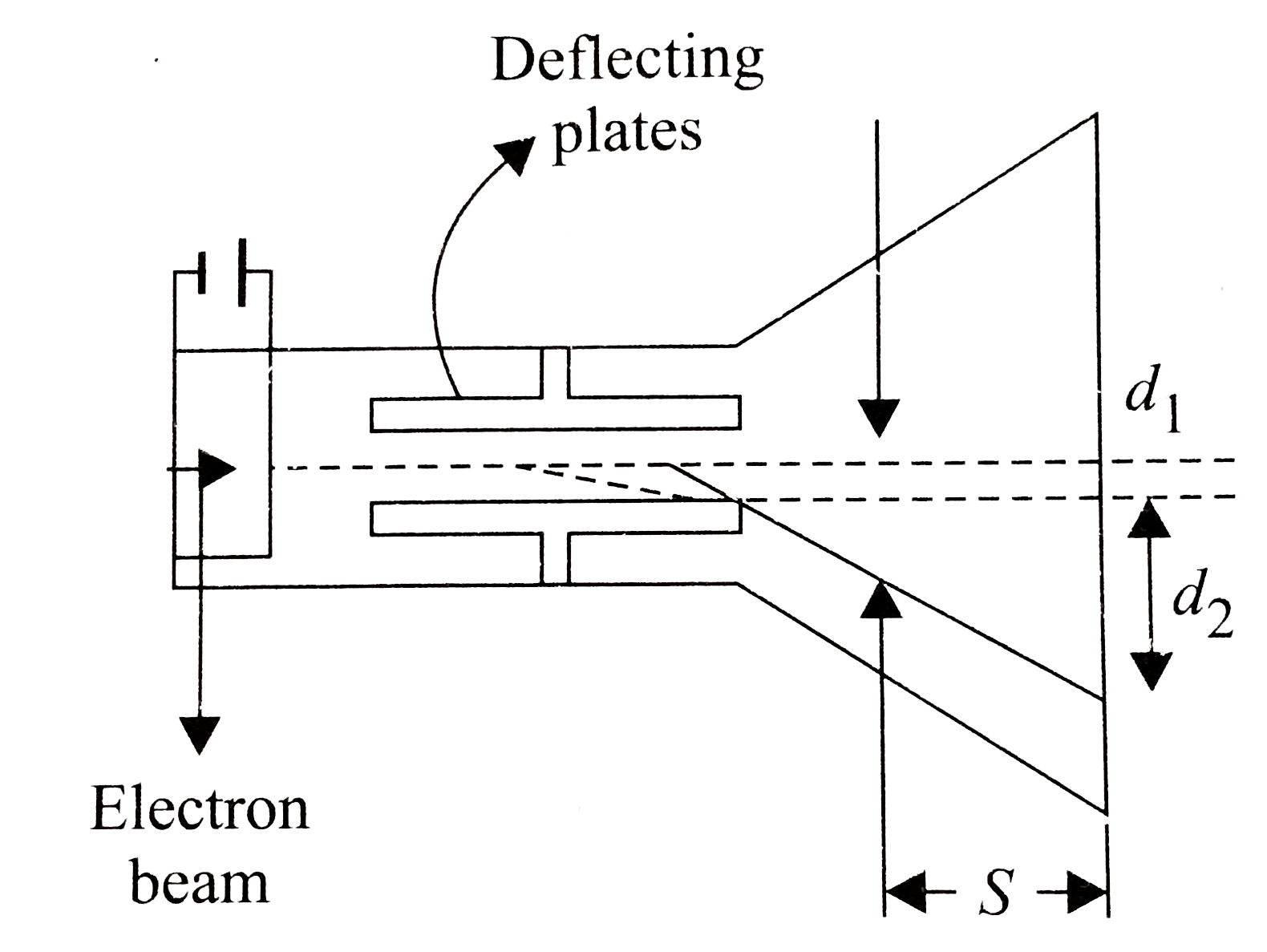
Electrons emitted from a hot filament are accelerated by a potential difference V. As the electrons pass through deflecting plates, they encounter both electric and magnetic fields. the entire region in which electrons leave the plates they enters a field free region that extends to fluorescent screen. The entire region in which electrons travel is evacuated.
Firstly, electric and magnetic fields were made zero and position of undeflected electron beam on the screen was noted. The electric field was turned on and resulting deflection was noted. Deflection is given by d1=eEL22mV2 where L = length of deflecting plate and v = speed of electron.
In second part of experiment, magnetic field was adjusted so as to exactly cancel the electric force leaving the electron beam undeflected. This gives eE = evB. Using expression for d1 we can find out em=2d1EB2L2
If the electron is deflected downward when only electric field is turned on, in what direction do the electric and magnetic fields point in second part of experimentView SolutionThe rediation emitted when an electron jumps from n=3→n=2 orbit in a hydrogen atom falls on a metal to produce photoelectron. The electron from the metal surface with maximum kinetic energy are made to move perpendicular to a magnetic field of (1/320)T in a radius of 10−3m. Find (a) the kinetic energy of the electrons, (b) Work function of the metal , and (c) wavelength of radiation.
View SolutionA thin rod of length L and mass M is held vertically with one end on the floor and is allowed to fall. Find the velocity of the other end when it hits the floor, assuming that the end on the floor does not slip?
View SolutionA parallel beam of light falls axially on a thin converging lens of focal length 20cm. The emergent light falls on a screen placed 30cm beyond the lens. An opaque plate with a triangular aperture, side 1 cm, is in contact with the lens
Which one of the following diagrams best shows to appearance of the patch of light seen on the screen?
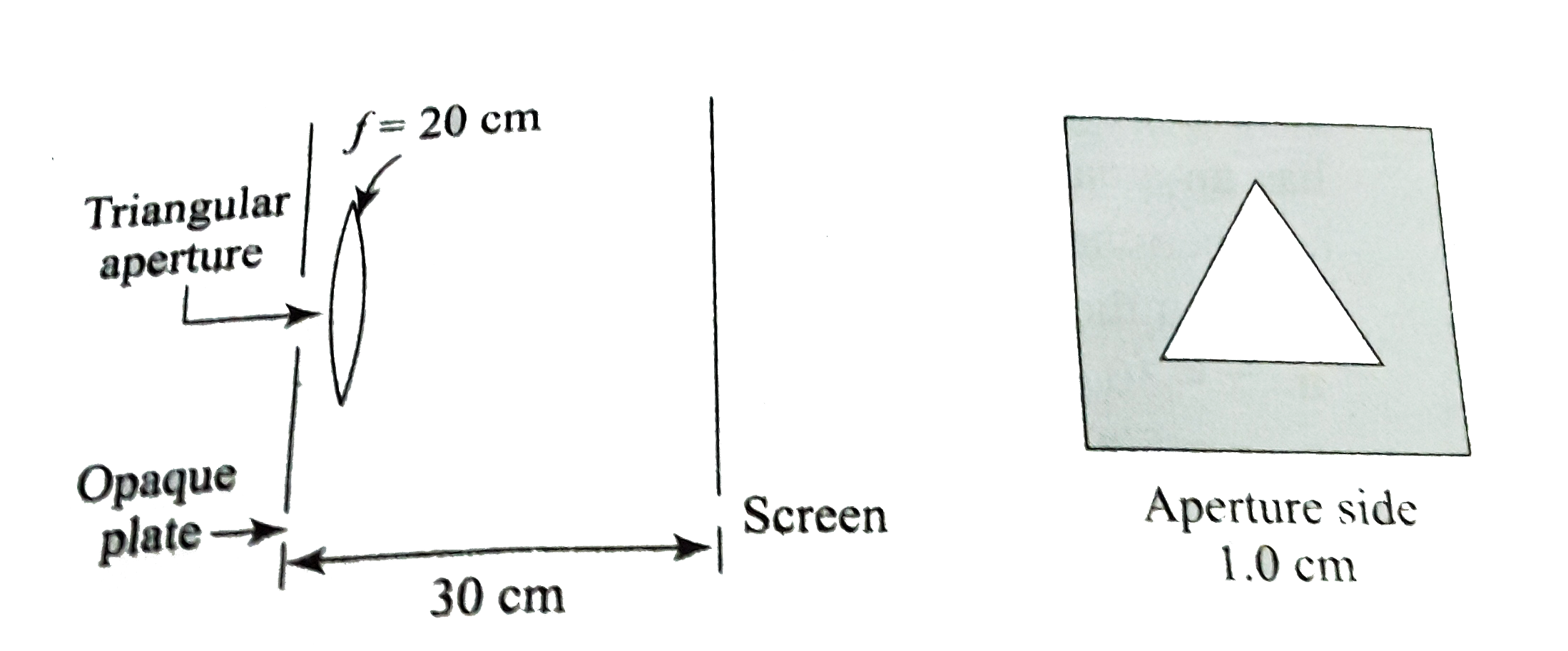 View Solution
View SolutionFig. shows a thin beam of white light from a source S striking on one face of a prism.
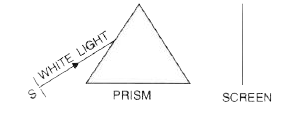
(a) Complete the diagram to show the effect of the prism on the beam and to show what is seen on the screen.
(b) If a slit is placed in between the prism and the screen to pass only the light of green colour, what will you then observe on the screen?
(c) What conclusion do you draw from the observation in part (b) above?View SolutionA beam of light of wavelength 600 nm from a distance source falls on a single slit 2 mm wide and the resulting diffraction pattern is observed on a screen 2m away. What is the distance between the first dark fringes on either side of central bright fringe ?
View SolutionA parallel beam of light falls successively on a thin convex lens of focal length 40 cm and then ono a thin convex lens of focal length 10cm as shown in figure.
In figure, the second lens is an equi-concave lens of focal length 10cm and made of a material of refractive index 1.5. In both the cases, the second lens has an aperture equal to 1cm.
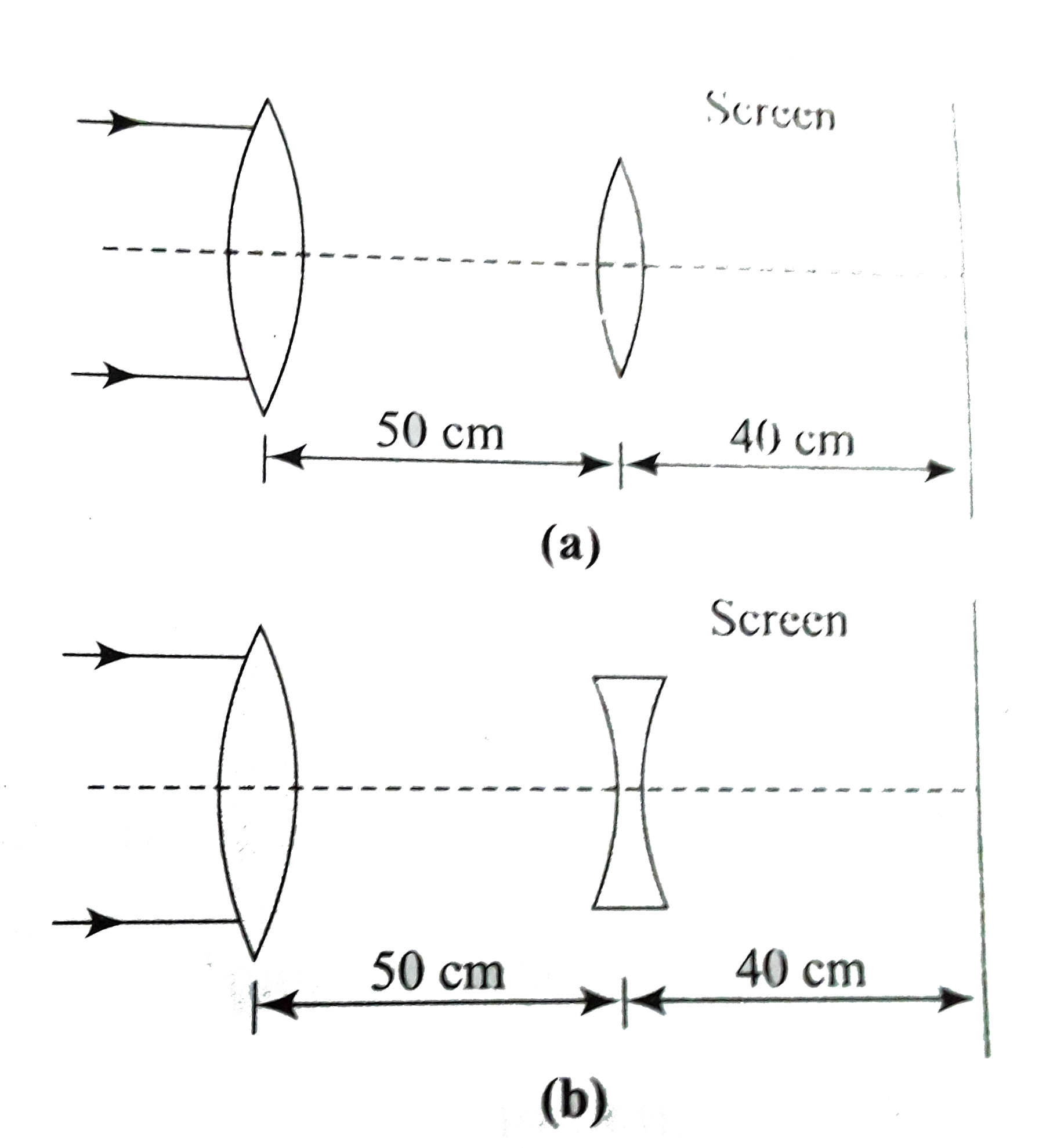
Q. Compare the area illuminated by the beam of light on the screen, which passes through the second lens in the two cases. The ratio (A2/A1) will beView Solutiona. Mark the follllowing statements as true offalse.
i. A ball thrown vertically up takes moretime to go up than to come down.
ii. If a ball starts fallig from the position of rest, then it travels a distance of 25m during the third secons of tis fall.
iii. A packet dropped from a rising balloon ferst moves upwards and then moves sownward as observed by a stationary observer on the ground.
iv. In the absence of air resistance, all bodies fall on the surface of earth at the same rate.
b. Fill in the blanks.
i. When a body is thrown vertically upwards, at the highest point.........................(both belocity and accelenation are zero//only velocity is zero//ony acceleration is zero). ii. If air drag is not neglected, then which is greater: time of ascent or time of descent?
iiii. A body is projected upward. Up to the maximum height time taken will be greater to travel...................... (first half//second half).View SolutionA YDSE is performed in a medium of refractive index 4/3, A light of 600 nm wavelength is falling on the slits having 0.45 nm separation . The lower slit S2 is covered b a thin glass plate of thickness 10.4 mm and refractive index 1.5. The interference pattern is observed on a screen placed 1.5 m from the slits as shown in figure. (All the wavelengths in this problem are for the given medium of refractive index 4/3, ignore absorption.)
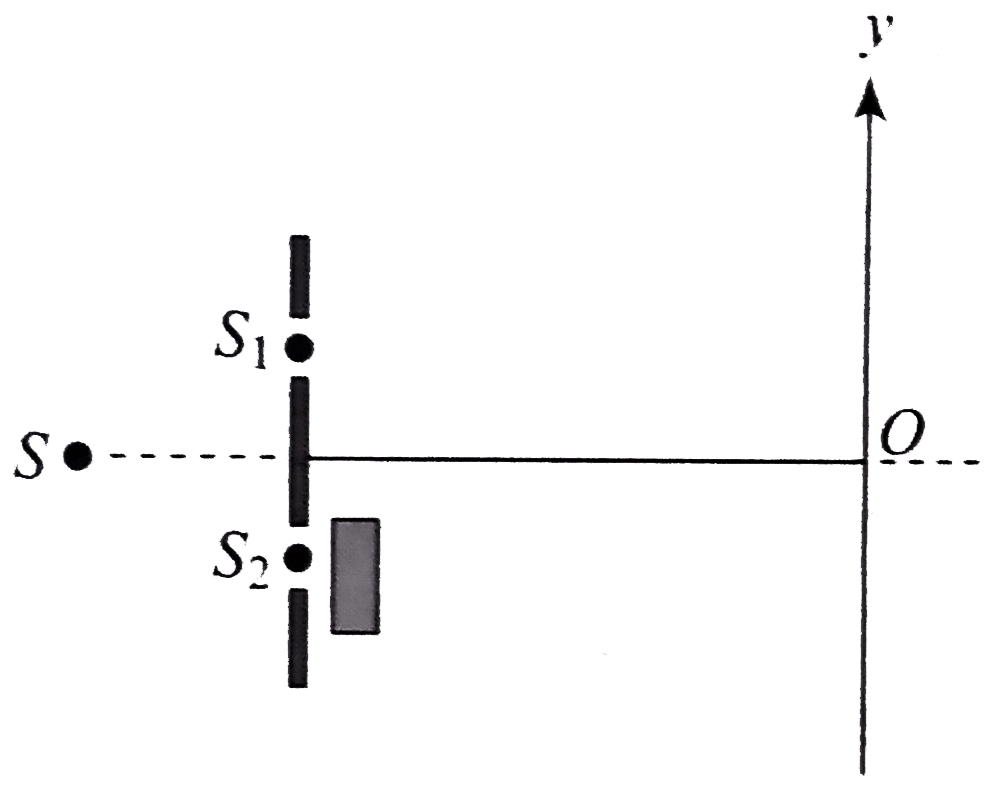
Now, if 600 nm, find the wavelength of the ligth that forms maximum exactly at point O.View Solution

